[brightcove video="747509045001" /]
Camelbak launched the hands-free hydration revolution years ago when it made the first-back mounted hydration system. Now, hands-free hydration is on the backs of hikers, bikers, service members and other outdoor types all over the world. The choices are plentiful, and while they all might look similar, there are vast differences between competing brands.
Most, if not all, manufacturers sell hydration packs with the reservoir systems included as an accessory. That's right — the basis of the whole system, billed as an accessory. Seems strange, eh? Well, let's use this to our advantage and look at the reservoirs themselves and how well each works so you can buy the bladder that works best for you and your pack configuration.
Read reviews of all the hydration systems here.
[brightcove video="749779166001" /]
more
We looked at flow rate, durability, ease of use, ease of cleaning and a bunch of other metrics and features to give you an accurate frame of reference the next time you look to replace or upgrade your current system. We did some destructive testing to get an idea how each of these would hold up if subjected to the rough handling of a speedball or logistics run. I'll call it the 6/50 drop test because I dropped a 50 lb. sandbag off the back of my truck from about 6 feet onto each reservoir. It loosely simulates the trauma as a bunch of packs are loaded or unloaded from the back of an LMTV or other truck. Batteries, ammo and other sharp-edged items may be up against the bladder, causing even more trauma during handling. The results are summed up and given some important context with each product, but we hope you found the videos entertaining and revealing. The best way to travel is with an empty bladder. [HUGE thanks to Military Times Senior Videojournalist Colin Kelly for shooting and editing our video.]
The Grinder was tough. None of the systems survived unscathed. Our durability wasn't meant to be withstood. It was meant to show how the reservoirs react when pushed beyond their intended use. Going into this test, I was expecting to use the data from the product failures to identify weak points in the design and manufacture of all the systems. That any survived was a bit of a surprise. Ultimately, durability was only one of several the factors used to determine which of the systems worked best on the battlefield and on the trail.
Durability aside, the next evaluation criterion was access. There's front fill port and open top. Each has it's up and down side. Fill ports are easier to fill, but harder to clean, though the larger openings mitigate this. The slider tops are easy to clean, but the slider doesn't stand up to pressure nearly as well as a fill port.
We then looked at things like bladder wall construction (flexible polyurethane vs. stiffer polyethylene), number and location of manual and automatic shut-off valves, detachable hosing for ease in routing, ergonomics, tube covers, flexibility for multiple uses, etc...
We'll first look at the three systems designed for the warfighter, then we will cover systems made for recreational use. Since the rec systems could be used on the battlefield, we subjected them to the same Grinder treatment as the .mil bladders so you'd have an idea how they'll do rucking instead of hiking.
Camelbak Omega Water Beast 102oz $38 (Note: the 80 oz. is pictured.)
The Omega is tough. No doubt, its thick polyurethane skin can resist all kinds of trouble and will bend like a reed in the wind around pokey stuff buried in a pile of packs. It held up the best in our 6/50 drop test, but not perfectly. The QR at the base of the bladder unseated after taking the sandbag drop. We were surprised and repeated the test with the same result. But, the reservoir didn't rupture and the fill port stayed intact. No material failure means if it leaks, you can refill it and fight another day.
Despite its durability, it's long in the tooth. When sealed, the fill port is very sticky. Opening it with cold hands — even warm hands — will make you feel like an arthritic grandma working on a new jar of pickles. The base has a QD port, but there's no automatic valve to keep the water from spouting when the hose is removed.
The hose itself is pretty well dialed. An inline shutoff valve works with just a thumb, and the neoprene cover keeps your flow cool or warm depending on the season. It also has the right bit of flexibility to keep it from flopping around without being too stiff. The flow is decent, although you'll have to suck a little harder to get the same amount of water through the tube compared to some of the other systems here.
Source WXP Helix Valve 100oz $36
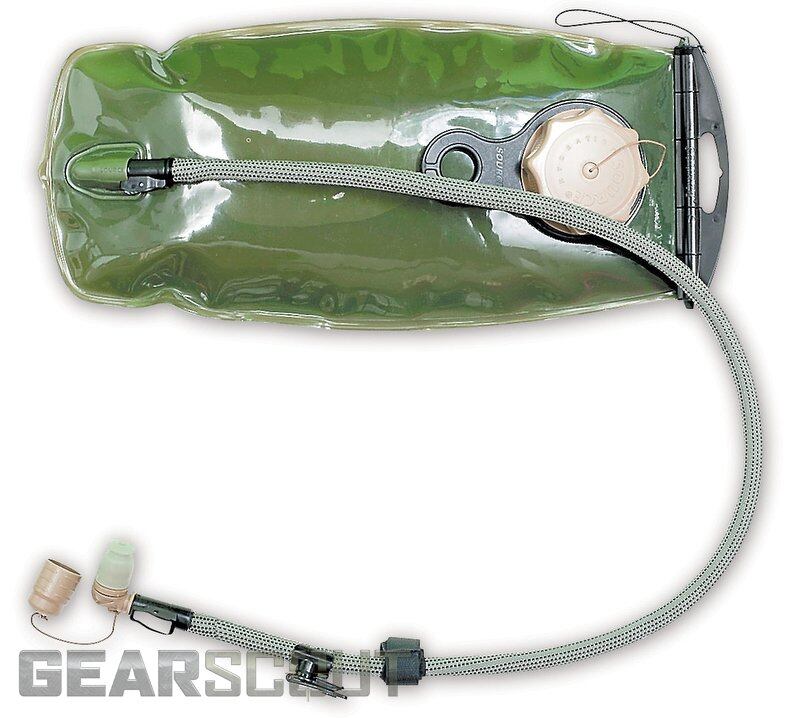
The Source WXP is almost perfect when it comes to battlefield hydration. The stiff polyethylene bladder may not be as strong on paper as the flexible polyurethane found in it's competitors, but we've yet to see or hear of a material failure in the field.
Feature-wise, the WXP has two openings for easy filling and cleaning. Use the fill port with the little handle for one-handed fillup. Slide the top open and get your whole hand and a towel in there for a crud sweep.
Source put a lot of work into the hose, too. It's the only system we've seen with auto-sealing QDs at both ends, so you can easily snap the reservoir into and out of other parts of the Source system. That comes in handy if you want to use your bite valve with someone else's bladder. It also allows the use of Source's very cool bottle filling adapter, the UTA. Snap this thing in place of your bite valve and backfill a bottle of water without pulling the bladder out of your pack.
There was an issue with the WXP Helix valve, though — it was the slowest in our flow test by a factor of two. Plan on sucking hard for your sips with the WXP.
When we put it in the Grinder, the WXP showed its hand. The slider along the top couldn't resist the pressure of the sandbag drop. It unseated and allowed water to pour out. On the plus side, like the Omega Beast, nothing broke. Slide the top back in place, dry your gear and use it later. Though, it didn't hold up to the static test. The pressure of 200 lbs forced the top off the bladder. So, load it up with water when you SP and you should be okay.
HTI Expedition 100oz $300

Filtering water is no fun. Pumping, squeezing, whatever — it's a pain and it's slow. What if someone made a hands-free hydration system that you could fill with puddle water and just start sucking it through the bite valve?
Meet the HTI Expedition, which stands alone among the systems we tested for its water-filtering process, called forward osmosis. The process needs a sugar to carry the clean water through the filter barrier, and this comes in the form of HTI's sports drink syrup packets. Snap a packet in place, squeeze to get it in the system, then fill the roll-top with dirty water. Seal it up and start drinking in a few seconds, with no pumping or waiting. Be advised that you don't get pure water; you get a Gatorade-like drink.
It broke my heart to drop a sandbag on it, but it's going to have to hold up to the rigors of the battlefield as well as any other. Pampering a hydration system is not a priority for the first-in teams that will likely use these. The results were good and bad. The reservoir held up, as did the filtering innards. The point of failure was the CPC hose end fitting. It cracked off, leaving the bladder and it's contents intact and unspilled, but the hose was done. If you've got a few spares, you can grab another hose and go, but if you're on your own be careful how you pack and treat that hose fitting.
If you have access to clean water, you can pull the filter out and use it like a regular Camelbak. It's a bit complicated and takes some extra care, but it's an awesome tool for first responders. Look for a deeper review on GearScout in the coming weeks.
Nalgene CXC 100 oz, $29
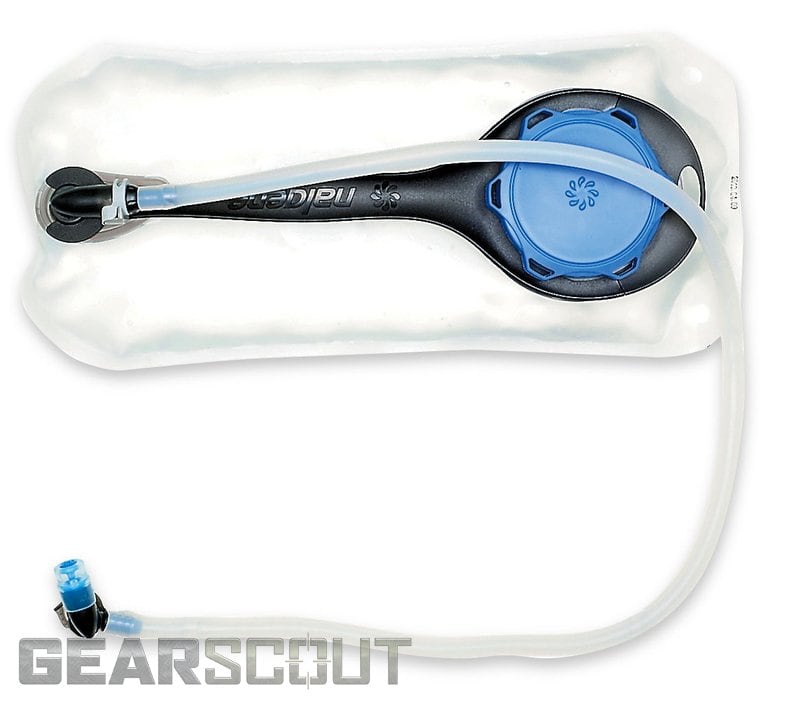
The CXC looked promising with its laboratory heritage, signature handle, high-end components and smart engineering. The handle makes the bladder easy to hold and fill.
Unfortunately, the thick hose became the weakest link. Its ends have only one barb and the lightest pressure made our test sample's hose slide off the fitting. This happened at both ends of the hose. The uninsulated hose also has a strong memory and wants to hold its shape in the most annoying, face-slapping manner possible.
Beyond the hose, the CXC has a medical-grade film reservoir that imparted no taste to the water from the get-go. Filling was an easy, one-handed job thanks to the handle — no overspill to wipe up. The cap offers ample purchase and screws on and off easily, which is important when tanking up in the cold. There's a strip of plastic that forms a sort of loose spring that holds the cap, so you can let it go during filling and not worry about loosing it.
The bite valve is omnidirectional, but it was the second slowest in the group we looked at, so you'll be taking smaller sips. We're hoping the tube on our sample was out of spec, but you'd do well to test one if you go with the CXC.
The Grinder proved out the problem with the hose fittings. They squirmed loose during the test and dumped water despite the shut-off valve in the base. Since the hose came off the fitting, the shut-off never came into play. Durability was hard to test since any pressure that built up during the sandbag drop forced the fitting to fail well before it could have an effect on the bag material.
Camelbak Antidote 100 oz $35
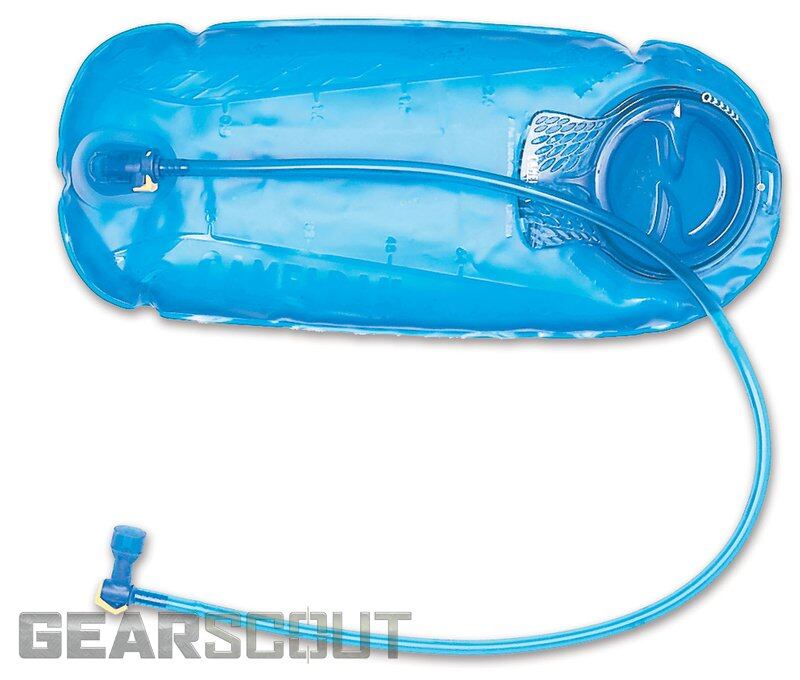
The granddaddy of hands-free hydration is still the one to beat, and the Antidote is the proof. The updated reservoir combines features spread across the Camelbak line into a tight package with a few new tweaks that scratch longstanding itches.
Opening the Antidote cap is easier than the old Omegas that always got stuck when screwed down tight. The handle makes for one-handed, spill-free filling, and the wider fill port would let Andre the Giant scrub the insides clean. New drying arms hold the bladder open for air drying. It sounds and looks gimmicky, it works.
The Antidote's textured, frictionless surface slides easily in and out of a bag even when wet. It works with any center-mounted reservoir hanger. According to our flow testing, the 90-degree bit valve flows easily and activates with a soft touch, but seals up leak-free when not used. The manual shutoff works with just a thumb; no need to pinch and twist — which can be a distraction during exertion.
When we put it through the Grinder, we had a surprise. The fill port leaked. We took a close look and found the locking teeth on the cap had cracked. I then remembered that we had gotten this Antidote bladder back in the summer as a prototype. To be fair, it was the only proto in the group. All of the other systems were full production. So, went back to Camelbak, confirmed that we had a pre-production sample and got some production versions to test.
The second test went better for the Antidote. We had one failure that I'll chalk up to a frozen sandbag. It was a lot colder than the day of the original test and the second sandbag I dropped was more like a brick than the heavy pack that it was supposed to simulate. I reset and used the same, less frozen sandbag and things went better. No leaks. No material or mechanical failure under a 50 lb drop test.
So, the results were a bit mixed. Though they point to room for improvement in the cap, I'm comfortable calling the Antidote the most full featured and durable reservoir in the group.
Hydrapak Reservoir II 100oz $30

The RII has a lot going for it. The body is light, small and bomber strong. The RF-welded seam (just one) is very supple, so the bag adapts to any shape without creasing. The downside: no baffle to help it keep its shape. That's not too big a deal, since it's the most flexible of the group, but it will turn into a sloshing back burrito if your pack doesn't have some support.
The roll top seals tight, but ours got sticky when we filled it. Empty, it's a breeze to slide the locking bar across the top. But, for no good reason, the bar gets harder to move when water is in the bladder — the plastic gets sticky when wet and binds the slider. We also noticed that the polyurethane bladder sticks to the sides of a pack when sliding into place. It's a bit of a pain to get the thing stowed down at the bottom of a pack hydration sleeve.
Something else to be aware of with an open-top bladder. Filling it in a shallow sink is a total pain in the ass. When you get close to filling it to the top, every shift in the bags position pushes water up and out. But at least you can get the Hydrapak in the sink. The other open-top, the Big Zip is stiffer and harder to bend under the tap.
The tube is covered with rubber and feels like the strongest of the bunch, but the rubber isn't as effective as neoprene for thermal insulation. The bite valve is very touchy and will flow and leak with light pressure. Best to use the bite valve lock religiously.
When it came to the Grinder, the Hydrapak gave up. The molded plastic slider split in two and sent all 100 oz of water jetting out. Worse, the lower edges of the fish lips cut the reservoir material and killed any dreams of field expedient repair. Despite the reservoir material's strength, the 10 cent clip at the top was revealed as the Hydrapak's weakest link.
Platypus Big Zip SL 100 oz $33
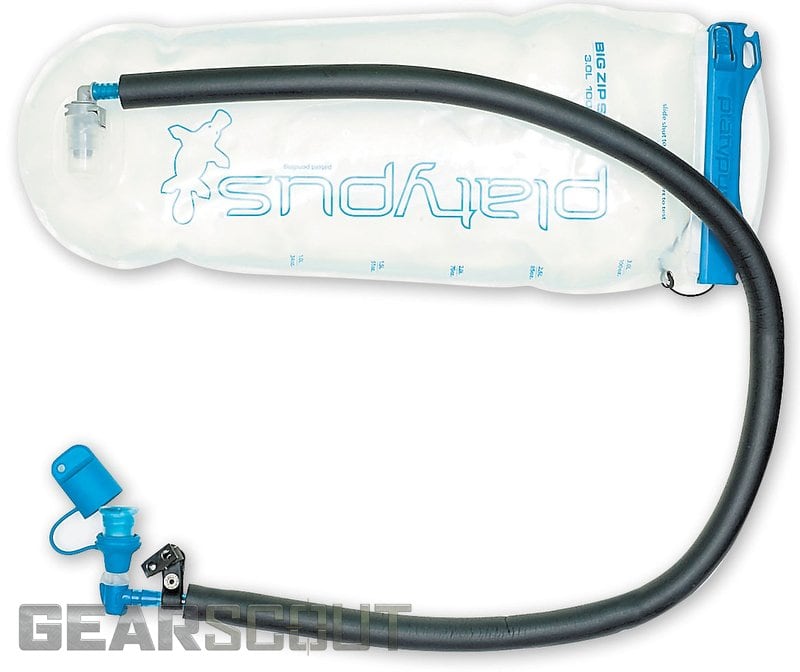
The Big Zip is a giant, tough Zip-Loc bag. Aside from it's comically large foam tube insulator, there isn't much to dislike about it. This and the Hyrdapak are the only two bags with a 90-degree valve at the base, making the bag easy to use when hung at a camp site for cooking or doing the dishes. The top handle and slick sides make it easy to install and remove from a pack sleeve.
However, filling the Big Zip is a two-handed job since the top wants to close and there's no handle on the bag itself. And, the open-top can be a pain when filling it up in a shallow sink.
The slider acts like the slider on a Zip-Loc bag. Once it's slid across the mating surfaces, it's just there as a handle. It doesn't exert any force holding the bag closed. That's probably why the top blew open when the sandbag hit it. It was a total failure in that the corners of the bag tore open, rendering the whole unit deadlined.
It has a self-sealing quick detach (QD) on the base and an effective, covered, bite valve at the top. Twist the head to shut it off, but ours never leaked in use.
Ultimate Direction 96 oz Reservoir 96oz $36
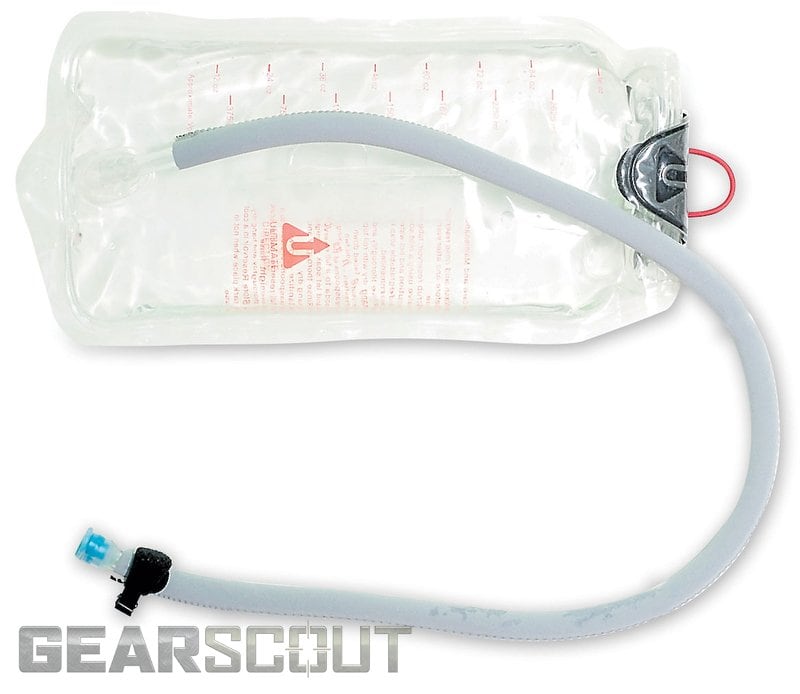
Think bare bones. When I bought my truck, I passed on all the bells and whistles. No electric windows, no auto door locks. All that stuff just breaks. The makers of the UDR seem to share that philosophy. No QD ports, no shutoff valves, no fancy slide top opening. It should be bomber, right? Well, when laid down flat, that Velcro-sealed top leaks like State Department cables on the Internet. And whatever grade of polyurethane they're using sticks to everything it touches.
On the plus side, it cranked on our flow test — the easiest and fastest-flowing reservoir we tried. You could probably shotgun the entire three liters in under a minute if you want to get wasted on water. Credit the lack of valves and 90-degree fittings for the speed. But without shutoff valves or QD fittings, the UDR is not the easiest to route through a pack. The interior baffle keeps sloshing down and helps the reservoir keep it's shape in your pack.
The UDR held up to the Grinder's first strike, weathering the bag drop. But, I suspect it survived because it had already started leaking from the top, lowering the pressure inside the bag. This became clear as the stream of water running out of the pack as I reset the test. If you don't plan on laying your pack down, throwing anything on top of it and can be meticulous when closing the Velco closure top, the URD is a good setup for recreational use.
Conclusion:
The only system that gets the fail is the Nalgene. It's really disappointing because the bladder itself is a dream to fill and place thanks to that handle. It also appeared fairly durable having survived getting run over by a truck. But, the hose fitting are horrible and WILL leave you with a wet ass at some point.
Based on the feature list and durability. The Source WXP edges out the Camelbak Omega Beast in the .mil arena. Even though the Camelbak held it's load in the drop test better than the Source, both were unable to cope with the 50lb bag drop. So, the Source WXP has a fuller feature set and is easier to slide in and out of a bag thanks to it's slick sides and detachable hose.
I know Camelbak is working on an update to their military reservoirs that address some of the issues with the sticky cap and lack of lower shut-off valves. If they can integrate the new Antidote features into a more durable milspec product, it'd be a winner.
On the rec side, the Antidote comes out with the right mixture of usability and durability. Price isn't a consideration since each of the systems is within a few bucks of its competitor. You'll have to pony up for a covered tube, unless you like sucking hot water in the summer, but with everything going for the Antidote (easy on/off cap, horizontal fill, auto shut-off at the base, drying arms and durability) it pretty much cleans up the lot of rec side hydration systems.
If you need simple and reliable for trail running, look at the Ultimate Directions. Looking for something to use on the trail and at the campsite, check out the Platypus or the Hydrapak. All three will do well.





